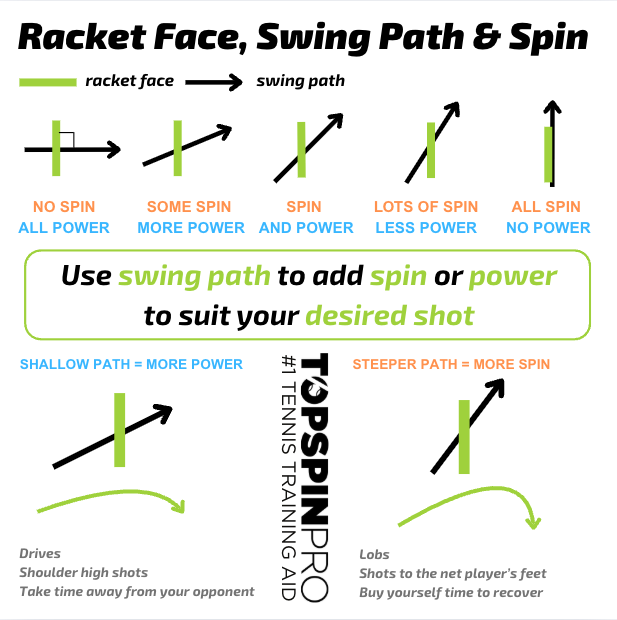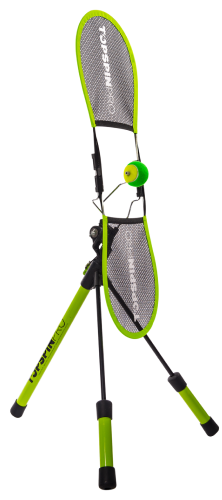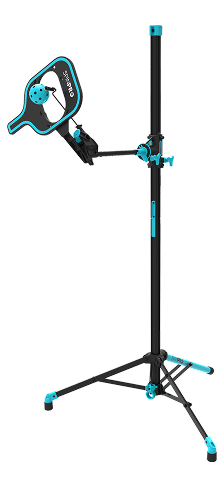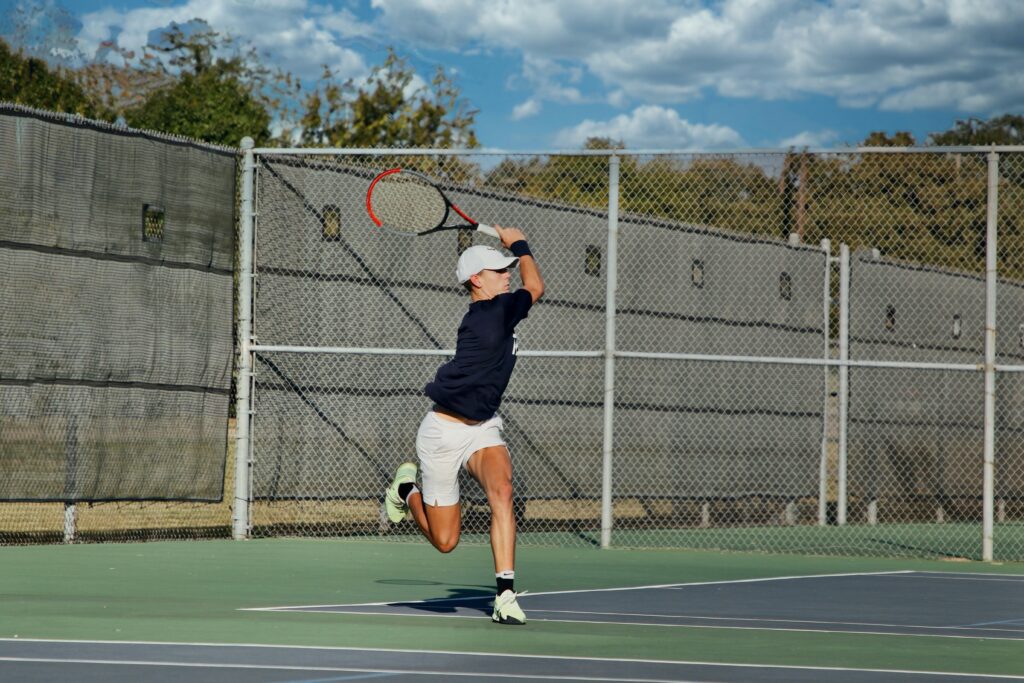For a lot of tennis players, adding topspin can feel like a balancing act. You’re aiming for that satisfying arc that clears the net and dips back into the court, but get it wrong, and the ball either flies long or crashes into the net. The usual response? Overdoing it with a wristy flick or forcing the motion altogether. So how do you develop a strong, consistent topspin groundstroke without losing control or tensing up? We look at how...
Why Topspin Is Important
Topspin isn’t just a flashy skill, it’s one of the most important tools for consistency and control in tennis. By hitting up the back of the ball, the forward rotation creates topspin, which causes the ball to dip faster than a flat shot. That gives you more margin for error and lets you:
✅ Hit higher over the net without going long
✅ Strike with more power while keeping the ball in play
✅ Open up wider, sharper angles
✅ Create heavier, more difficult shots for your opponent
For a full in-depth guide to topspin check out: Why Topspin In Tennis
Offence
Topspin expands your offensive options. With reliable spin, you can hit deep, aggressive groundstrokes that push opponents back, attack cross-court or down the line with pace and control, dip balls at your opponent’s feet, making net-rushers uncomfortable, use lobs, topspin passes and sharp angles more effectively
Defence
Defensively, topspin buys you time helping you recover quicker, reset rallies, or counterattack. It gives you more options to stay and the game and keep you from panicking!
In short? Topspin gives you freedom: to attack, defend, and control the game on your terms.
For a more in-depth guide on topspin tactics check out 8 Tactical Uses Of Topspin
Common Mistakes When Adding Topspin
Topspin is incredibly useful, especially under pressure, but only when applied with the right technique. When players try to force topspin without understanding the proper mechanics, it leads to loss of control, bad habits, and even injury.
Here are some of the most common mistakes:
1. Hitting The Top Of The Ball
The name “topspin” can be a little misleading. It sounds like you’re supposed to hit the top of the ball, and in some sports, that’s partly true. But in tennis, that approach won’t work. To generate effective topspin in tennis, you actually need to roll your strings up the back of the ball, not strike the top. Topspin is created with friction, as your strings travel from low to high, lifting the ball upward and forward in one smooth motion.
👉 If you try to hit the top of the ball, you’ll simply drive it downward, causing it to drop short or hit the net.
By learning to hit up the back instead, you’ll develop a true topspin shot that gives you both safety and attacking potential and that’s where tools like the TopspinPro really shine, by reinforcing the correct biomechanics.
2. Swiping Across the Ball
Many players end up exaggerating their swing and swiping across the ball, forcing the finish. This leads to mishits and shanks, lack of control and depth (tends to send it low and cross court with sidespin instead of true topspin.
👉 Focus on a low-to-high swing path, rolling strings up the back of the ball and a high finish.
3. Overusing the Wrist
A wristy flick might feel like it’s adding spin, but in reality, it usually leads to strained tendons, tennis elbow, and other wrist or forearm injuries. It’s one of the most common misconceptions among players trying to learn topspin. Many players see the racket “whipping” through contact and assume the wrist is actively doing the work, but that’s not the case.
While the wrist stays relaxed, it should remain stable through contact, allowing the racket to move around it naturally. That “whip” effect actually comes from pronation in the forearm and a fluid kinetic chain, not from snapping or forcing the wrist.
👉 If you want to feel the correct motion without overusing your wrist, tools like the TopspinPro can help you build the right biomechanics safely and consistently.
4. Late Contact Point
When players try to exaggerate topspin, they often fall into the trap of swinging too steeply with a “buggy whip” type finish, where the racket wraps up and around the head after contact. This can feel flashy, but it often causes late contact and poor timing, especially for recreational players.
The buggy whip can be effective in very specific situations, which is why you’ll sometimes see pros use it. It’s especially useful when they’re under pressure and the ball is rising fast and they need to improvise or they’re dealing with a low ball that needs extra lift.
But here’s the key: pros use it as an adjustment, not a default swing. For the average player, copying this style too early often leads to inconsistent contact, poor balance and less power and control.
Instead, focus on mastering solid fundamentals first with one clear, efficient swing path. It's important to aim for correct biomechanics that give consistent contact point, a smooth low-to-high motion and a clean, repeatable finish. Repeating the same swing will improve your tennis faster. Once you’ve built reliability and control with that core swing, then you can explore variations like the buggy whip for specific tactical situations.
For more tips read our guide on How To Improve Tennis Fast: Tennis Skill Progression Guide
👉 Aim to make contact consistently out in front of your body
5. Tensing Up Or Forcing the Shot
Topspin doesn’t come from muscling the ball, it comes from fluid, well-timed movement. When players try too hard to generate spin, they often grip the racket too tightly, tense up through the shoulders, and rush the swing. The result? A stiff, jerky motion that actually reduces spin, control, and power, the exact opposite of what they’re trying to achieve.
If you’ve ever watched top-level junior players or pros, you’ll notice they often look incredibly relaxed, almost floppy, like they’re barely holding the racket. But that looseness is exactly what allows them to generate maximum racket head speed meaning effective power and topspin.
👉 Relax your grip, breathe through the swing, and trust your technique. Playing with compression balls can help develop a lose swing.
Check out our in-depth guide to Common Topspin Forehand Mistakes: What's Holding You Back?

How to Hit With More Topspin and Stay in Control
Now you are aware of some of the common mistakes and some tips to help avoid them, let’s look at some other key adjustments that can unlock reliable, controlled topspin.
1. Get The Biomechanics Right
As we have already discussed topspin is created by brushing up the back of the ball, not hitting flat through it. Master the correct contact point biomechanics and you will improve fast!
Also, understanding the physics of the swing will help you advance faster (see the image below). Knowing what you are trying to achieve translates to correct swing shape. This is where the TopspinPro can transform your game. Instead of guessing or hoping your technique is right, the TopspinPro trains the exact path of the racket at contact and the ideal racket face angle to achieve maximum topspin.

2. Use Your Whole Body
Proper body positioning and footwork are essential for generating topspin and maximizing power through the kinetic chain, the sequence of movements that transfers energy from the ground up through your body and into the racket.
Real topspin starts from the legs, not the wrist or arm. It’s all about harnessing your full body efficiently:
• Load your legs and stay balanced
• Use a unit turn on your backswing to engage your core
• Uncoil through the shot in a smooth, relaxed motion
When players first try to add topspin, they often tense up, afraid that using more power will make them lose control. Ironically, the more you engage your entire body, the easier it is to produce controlled, heavy topspin. The extra spin gives you more margin for error, not less. Focus on rhythm over force. Let your body work as a connected system, and you’ll find that spin, power, and control all start to fall into place.
3. Practice The Correct Way
Don't expect a miracle. Nothing in life comes without hard work and the same applies to your tennis game. Put in extra practice and you will be rewarded, but make sure that practice is structured and relevant. There's no point rushing to matchplay when you haven't mastered your topspin yet. Technical and drill progressions are key here. Read our full guide: How To Improve Tennis Fast: The Skill Progression Guide
4. Have A Tactical Intention
A loss of control in your shots often stems from poor technique, but just as often, it comes from a lack of purpose. That’s where tactical intention becomes crucial. Tactical intention means approaching each shot with a clear plan or objective. It’s not just about hitting the ball, it’s about understanding why you’re hitting it a certain way and what you want it to achieve in the rally.
That intention could be as simple as hitting cross-court, lifting a deep, high topspin ball to buy recovery time, targeting your opponent’s weaker side or pulling your opponent off the court to open space
When you have a tactical intention your body begins to coordinate more naturally: footwork sharpens, preparation becomes quicker, and your swing technique matches the shape and purpose of the shot. On the flip side, when you hit without clear intention, your technique tends to fall apart and you rush.
For more on tactical intention read: Use Tactical Intention To Master Your Topspin
TOPSPINPRO BEGINNER COURSES
If you need a little extra help with your topspin, we use the science of progressions in our TopspinPro Online Courses. Check them out for some in-depth help with developing your shots:
Summary
Adding more topspin to your game should make you feel more confident, not more chaotic, rushed, or unsure. The goal isn’t to swing harder or faster, it’s to develop a swing that’s efficient, repeatable, and built on solid mechanics.
Too often, players overcompensate with tension or effort, thinking they need to force spin. But true topspin comes from fluid movement and smart mechanics, not brute strength. As your understanding grows, so does your ability to hit with confidence.
So if you’re tired of second-guessing your forehand or watching shots sail long or into the net, start refining your spin the smart way. Focus on building clean, reliable technique, and you’ll develop a forehand you can trust in any situation.
FAQs
-
Why is topspin considered an important skill in tennis?
Topspin is crucial for consistency and control, allowing players to hit higher over the net without the ball going long. It also lets you strike with more power while keeping the ball in play, open up sharper angles, and create heavier shots that are difficult for opponents to handle.
-
What are some common mistakes players make when trying to add topspin?
Players often make mistakes like hitting the top of the ball, swiping across it, overusing the wrist, making late contact, or tensing up. These errors can lead to loss of control, bad habits, and even injury.
-
How can players generate effective topspin without overusing their wrist?
Effective topspin comes from using a relaxed wrist that stays stable through contact, allowing the racket to move naturally. The “whip” effect is from pronation in the forearm and a fluid kinetic chain, not from forcing the wrist.
-
What role does body positioning and footwork play in generating topspin?
Proper body positioning and footwork are essential for generating topspin, as they help maximize power through the kinetic chain. Real topspin starts from the legs, utilizing the whole body in a smooth, relaxed motion.
-
How does having a tactical intention improve topspin shots?
Tactical intention involves approaching each shot with a clear plan, which helps coordinate the body naturally. This sharpens footwork, quickens preparation, and aligns swing technique with the shot’s purpose, reducing rushed or uncontrolled hits.
Enjoyed this article?
Be sure to sign up for our newsletter and we'll keep you up to date about new posts



